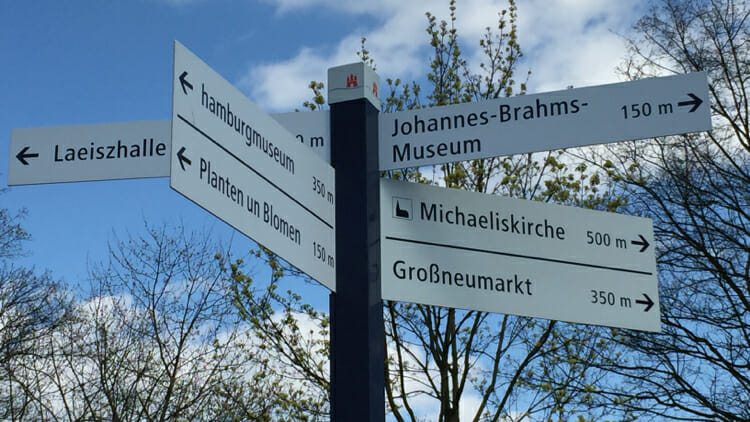
You don't need a good sense of direction to navigate a new city.
It helps. But it's not necessary.
In answer to the many emails of concern I've received from solo travelers who are afraid of getting lost, this post is on how to navigate a new city with some information on how to learn a new transit system and specific tips for navigating some of the most popular cities in the world.
My aim is to make getting around any new city easier. I'm going to try to help you:
- uncover the logic of a city. Once you find it, you will be less likely to get lost.
- develop a sense of direction. It's a skill and, like most skills, with practice you can get better at it.
- understand where in a city it is typically safe for solo travelers and where it isn't.

General Tips on How to Navigate a New City
- Yes, you can use Google Maps and Waze, but… These two apps can be downloaded onto your phone for free and will help you get just about anywhere. They are great for navigating when you're having trouble finding a place but I don't recommend using them all the time. They certainly don't help you learn how a city works and they don't reveal the lay of the land. Go off Google Maps with the following tips.
- Know which way is up. In Toronto, the lake is south. And because the CN Tower is just about on the lake, if you can see the tower in the sky, you're looking south. Turn around and you're looking north. East is on your right and west is on your left. Yonge Street divides the city between east and west. Once you know these few tips, it's much easier to understand Toronto. I have a similar approach to New York City as you can read in the caption of the image above. I do this in every city. I look for the landmarks that will help me understand the logic of a city.
- Use the compass app on your phone. There are times when it is difficult to know which way is up, such as when you come up to ground level from a subway station that has many exits. Use the compass on your phone to re-calibrate which way is up.
- Look for signs that say centrum, centro, centar, centre-ville, Zentrum, or Stadtmittej. Cities throughout Europe are well marked with signs that point you to the city center. These are particularly helpful when navigating cities that are not organized on a north/south grid.
- Research the transit system. By going to the website for the city's transit system, or, in the case of a foreign language, searching for the information online, you'll find out how it works, what it costs, and what forms of payment are accepted. Do your research first. Before going to a new city:
- Know how and where to buy access to the transit system. You may need a special transit card as you do in London and Sydney. Know your options.
- Check to see if the transit system has an app and download it.
- Study the transit map looking for the main lines. In Toronto, it's pretty easy to get a handle on the system. In London and New York, you need to rely on their transit app to get where you're going.
- On a bus, sit by the driver for direction as to when to get off.
- Take photos as you go. You can create a bread crumb trail with photos in cities that have you really nervous. I did this in Moscow where the signs are all in Cyrillic script, making them impossible for me to read. At every turn, I swiveled around to face the direction I would approach it from when returning back to my hostel and took a photo, thus creating a visual map. I didn't need it in the end as my sense of direction got me back safely but it was a back-up in case I needed it.
- Have a few key words in your back pocket. Yes, your back pocket. Writing the basic information you'll need and a few key phrases on a piece of paper in English, followed by the phonetic spelling in the language of the country, followed by the proper spelling in the local language, will be helpful. In Japan, before moving on from one hostel to another, I always had the name and address of my destination written on a piece of paper in Japanese characters. Even if I knew the name, I couldn't be sure that people would understand what I was saying and I certainly couldn't expect people to read the destination in Latin script.
- Use visitor centers and their act-alikes. A visitor center will have much of the information you need and the staff will take the time to help you out. They are usually located in the city center or the train station. But, what if you don't know where it is? Don't panic. Go to any hotel (or restaurant in a pinch). The higher end hotels are great for this. Most staff will speak English and, while the concierge is supposed to be for guests, they may assume that you are one. If they know you're not and they're not busy, they'll likely be happy to help anyway. In Tokyo, I went to the Shangri-La Hotel with my backpack on. Clearly, I was not a guest. But I was greeted with the same courtesy and received the same help as if I had been one.
- Be proactive. If you're unsure of yourself, ask for help. Standing around looking dazed will not get you where you want to go and it may get you noticed by the wrong people. It would be a strange occurrence for you to choose to ask the wrong person for information, so go ahead, smile, and ask for help.
- Stand back and watch. Navigating a new city will be easier if you give yourself time to observe things like how to get a taxi–whether you can flag one down or you have to go to a taxi stand–and how people wait for buses and subways.

How to Develop a Sense of Direction
In 2001/02, we had a major travel adventure as a family. At that time, I taught my children how to navigate a new city. One was only 11 years old and it wasn't long before he could lead us through a train station or direct us in a new town. Yes, becoming city-savvy is possible even if you don't initially understand how the city works.
True, navigating a new city is easier if you have a good sense of direction. But what if you don't think you have one? Don't worry, it can be developed.
One's sense of direction appears to be dependent on language. There are two ways to speak about space and directions.
- Egocentric: These are terms that are relative to your body. For example: turn left, walk forward for two blocks, and your destination will be on your right.
- Geographic: These are terms based on the points on the compass. For example: walk west for two blocks and your destination will be on the north side.
Research shows that in cultures that speak in terms of where something is relative to the individual–in egocentric terms–people are less likely to have a good sense of direction. The more a society speaks in terms of geographic directions, the more likely it is that members will have a good sense of direction.
This knowledge presents an opportunity to develop your sense of direction. If you want to improve your sense of direction:
- Spend more time thinking about which way you're facing in terms of points on the compass.
- Walk around your block with awareness of what direction you're facing. Then walk progressively more complicated routes focusing on your direction.
- Give other people directions based on the compass. You can even make a game of it in the form of a scavenger hunt.
Evidence shows that, with practice, you can become more intuitively aware of your geographic location. Add to this some landmarks that you'll notice along the way and you should be able to find your way around more easily.
Exploring a new city, learning how it works and how people live in it, are fascinating aspects of travel. Go with confidence and explore.

Determining Safe Places When Navigating a New City
When you're in a new city, it's important to know where it is safe to be and where it is not. What's safe is easier than what's not so we'll start here. I've said it before, public is always safer than private. In public we are naturally protected by social values. In private, we are subject to the values of those around us. That's why these tend to be safe places for solo travelers.
- Places where families go tend to be safe. If it is designed for and attracts families, it is safe.
- Typical tourist sites such as museums, churches, and castles are safe.
- Well traveled hiking trails (if you see someone every few minutes) tend to be safe.
- Small towns, where everyone knows everyone, tend to be safe. They keep each other in check.
- Public spaces in cities such as markets, pubs in good areas, and shopping districts are safe.
But there are also places that are not as safe for solo travelers. Sometimes it's obvious when a place isn't safe. Other times, it's your Spidey senses that tingle and tell you to leave. Listen to them. Here, again, are some generalizations.
- Restaurants and other places near train stations. It's not that these places are unsafe in and of themselves, it's that these are natural places for people to hang out who want to scam or pickpocket a tourist. If you need to go to a restaurant near a train or bus station, try going a few blocks away.
- Remote areas for hiking or camping where there is no chance for help if required. They require extra precautions.
- Bad parts of town. There are areas in almost every town and city that are not safe and you can't always tell by the way they look. A nice looking neighborhood could have things going down that you don't know about. Likewise, what you consider dangerous looking at home could be very safe in another country. Don't judge an area by the looks of it as much as by the people who are in it. If you think you may have entered an area that isn't quite right, leave. If you don't know how, choose your person carefully and ask for directions.
- Bars. I like going out to live music venues at night but I'm very careful about where I go. I check out the place in guides and online but I also get a local's take on the place. Is it a place they would send their sister alone?
- Private spaces. Any time you go out of the public sphere with someone you lose control of the situation. As a solo traveler, I don't like losing control. Don't go to after-hour parties in places you don't know, house parties, private cars, or cabs with strangers.
When traveling alone, it's important to remember that the place you're staying is your most important safe place of all. Try to keep your accommodation to yourself. Meeting new people while traveling solo is a wonderful experience but an evening is not enough time to know a person's character. Keep the name and location of your hotel, B&B, or hostel to yourself so that it is always safe. You may want to have a read of Solo Female Travel Safety: Answering a Stranger’s Question-Or Not in which members of the Solo Travel Society share their strategies for responding to questions that begin with, “Are you by yourself?”

Are City Centers Safe at Night?
History and demographic shifts affect the nature of cities. This may make little difference to your safety during the day, but, when it comes to night, it could be a big deal.
While it is always a problem to generalize, I'd like to offer a broad interpretation of the city centers (or downtowns) of the three most popular destinations for our readers. To reiterate, these are generalizations. Please, always ask at your hotel, hostel, or B&B to confirm that your destination is in a safe area.
Europe – The centers of major cities in Europe are generally alive night and day. Wandering the centers of Paris or London and other European cities, even at night, is usually no problem. The cities are so busy with locals who live in the city centers and tourists who want to be in on the action that you will typically be safe. For more on how Europe works I suggest Solo Travel Europe: 32+ Tips You Need To Know.
United States – Uptown Manhattan is safe just about any time of day or night, however, the movement to the suburbs in America has made some cities' downtowns very quiet after the business crowd goes home. This can make safety questionable. To know whether the downtown area is safe, look around. Are there condos in the downtown? Are people living there? If yes, it's likely safe. For more on how the US works I suggest Solo Travel to America: 32 Tips.
Canada – Most centers of Canadian cities are alive and safe as the movement to the suburbs was not quite as complete as it was in the US. However, still, before heading out, especially in the evening, confirm that your destination is safe.
I hope these tips help as you enter a new city to explore. If you have suggestions for navigating a new city on your own, please leave them in the comments section below.
